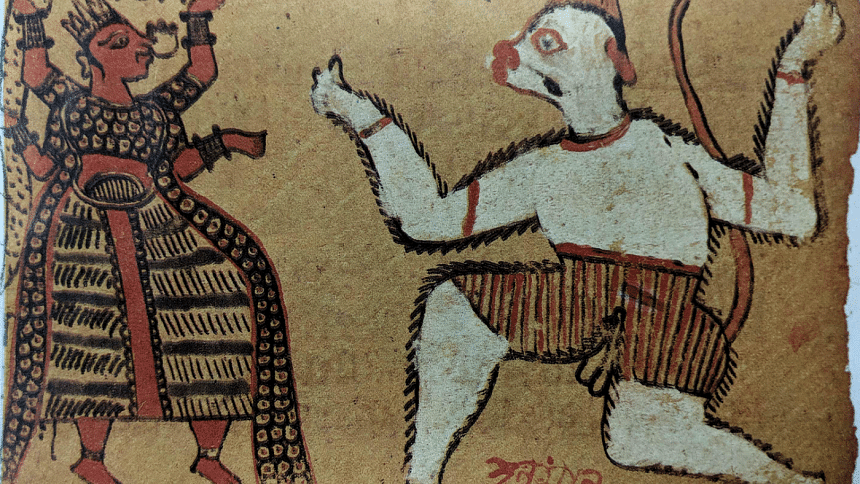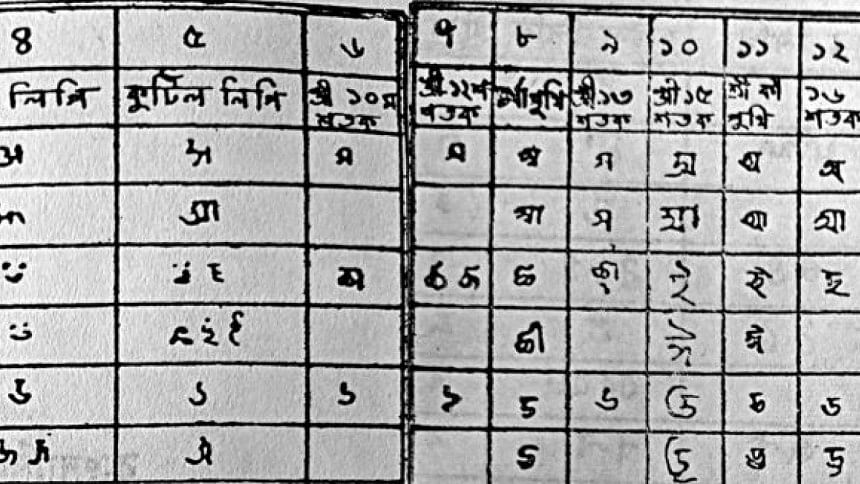The unexplored treasures of old Bengali manuscripts

We know that the Bengali language has a thousand-year-old history. But we don't talk about Bengali works from the old and middle-periods except some common names such as Charyapada, Sunyapurana, Vaishnava Padavalis, Mangalkavyas and some adaptations of Arabic and Persian romances. Moreover, earlier there was an enthusiasm among scholars for editing and compiling these old works which is now almost non-existent. What is your opinion regarding this observation?
Old Bengali is not being studied anymore. It is as if all that is worth printing from old Bengali works has already been printed—the rest can be discarded. Research on old and middle-period Bengali has become a matter of shame for our present-day researchers. There are 30,000 punthis in the collection of Dhaka University. All these documents are gathering dust without being compiled and published. You will find very few researchers who are interested in working on this topic.
Old Bengali documents are a treasure trove for both the linguistic and socio-cultural history of the country. It can shed light on many unexplored areas of Bengali language and culture. If we can properly research and publish these documents widely it can bring about a cultural revolution in the whole Bengali-speaking region. For example, a comprehensive story of Bengali prose is yet to be written. Till now, we have written the history of old prose using very few documents that are publicly available. So far, the oldest specimen of Bengali prose is considered to be a letter written by the King of Cooch Behar to the King of Ahom Raja in 1555. But there are other old Bengali documents in the collection of different archives of the country. I have compiled 119 old letters and legal documents in my book Purono Bangla Dalilpotro (1638-1882). These are important examples of old Bengali prose.

The study of these manuscripts is also important for understanding the evolution of Bengali script. From the existing evidence we can trace the Bengali script to the ancient Brahmi script. We get the complete form of Brahmi in the Ashokan rock edicts. In Bogura's Mahasthangarh we have found an epigraph which is written in Ashok's Brahmi script. The language of the epigraph is Prakrit. The next example we can find is handwriting from the Shushunia Hill in West Bengal dating from the fourth century AD. It was written in a developed form of Brahmi in the Sanskrit language. During the Kushan period the script remained almost same. During the Gupta period (the third century to the fifth century) a derived form of Brahmi was used. After that, the scripts used during the Pal period (from the eight century) and the Sen period (from the 10th century) were all derived from the Brahmi script. Documents found from the 13th century were also written in scripts which came from Brahmi. At different times in this region, different languages were used, but the script for all of these were derived from the Brahmi script. Indeed, in the subcontinent, all scripts used, except for Urdu, derived from Ashoka's Brahmi. In different regions, they went through different courses of evolution, so they look very different now.
Sanskrit, Prakrit, Apobhrongsho or Bengali—whichever language was used in this region, the script used was the Bengali script. Bengal, Bihar, Orissa, Assam, Nepal were the regions where what we call the old Bengali script was in use. Till the 12th century, the scripts for these regions were the same. In the 13th century, the Orissan script underwent changes—some letters started being written differently. The Bengali script of the middle ages was used in Bengal, Assam and Tripura.
In 1778, Bengali script was first used in print in Halhed's A Grammar of the Bengal Language using Sir Charles Wilkin's Bengali type. Wilkins had used handwriting from that time as the reference for his type. From 1778 to 1820, for roughly forty years, the type script of some Bengali letters underwent changes. From afterwards, till today, Bengali type script is more or less the same.
But, our joint letters have a history of their own. We can, for example, find how the letters ka (ক) and ta (ত) were written tracing them back to their early forms. We can also find how their joint form, the kay-ta (ক্ত) was written. The individual letters could be clearly identified in their joint form in Ashok's Brahmi script. But today, the two letters cannot be identified separately in their joint form. That is because the joint form evolved separately, following its own course. This history needs to be written; we do yet have an exhaustive history of how the joint forms of letters evolved.Old manuscripts can be a great source of early specimens of these changes.

The government should take an initiative to publish these documents in the modern script alongside the original scripts in which they were written. Studying these documents will also let us add a lot of words to our vocabulary that are not included in the existing dictionaries.
Besides our linguistic history, these old documents can be an important source of writing a comprehensive history of this region. The Archaeology Department has a huge collection of Nawabi documents. These are dated; the names of the writers and where they were written are included in these documents. These documents can be used to even write village-specific histories of the country since almost all parts of the region were administered under the Nawabs.
You have worked on the evolution of village names in Bangladesh. Please tell us about this project.
I have been working on this topic for a long time. I have collaborated in a government project of compiling the Bengali names of the all the villages in our national statistics. I have produced four books on this topic. One of them is Bangladesher Shamorik Podobijuktu Graamnaam (Village names with military ranks in Bangladesh). I found that 1016 village names are based on 47 military ranks from before the 18th century. This can be a great source for writing the military history of the pre-modern period.

For example, there are 52 villages in the country with the word bajit (বাজিত) in them, such as Bajitkhan, Bajitkhila, Bajita and so on. Bajit comes from the Sanskrit word Baji which means horse and bajit means horse-rider or cavalry. Similarly, the Arabic word for a stirrup for a horse rider is Rikab. When the Bengali ee (ঈ) suffix is added, it becomes Rikabi (রিকাবী) which used to denote a cavalry rank. There are four villages in Bangladesh that have the word Rikabi in their names: Rikabi, Agat Rikabi, Rekabibazar and Rikabibazar.
Earlier there was a custom of granting villages to soldiers for maintenance of the force or as a reward for their bravery in wars. These village names with military ranks bear the history of this administrative practice.
I have also worked on hunting-related names of villages. For example, Shikarpur in Barishal—there are 48 Shikarpurs in Bangladesh. It indicates that there used to be designated places for hunting in this region. We also find this reference in the work of the great Mughal historian Abul Fazl.
Research on village names will enrich our Bengali vocabulary. At the same it can provide living evidence for writing a comprehensive social and cultural history of the country.
There is a long tradition of using illustrations in local manuscripts. What does this practice tell about the art history of this region?
During my work in the Dhaka University Archive, I found many illustrated punthis. These illustrations were used to portray the main themes or some interesting part of the manuscripts. I want to highlight one such punthi of Manasa Mangal which was written around 1805 in Tangail. It contains 37 illustrations. The artist was Noyan Krishna Ghosh. I have used these illustrations in my book titled Padma Puran. I also showed these illustrations to some renowned art historians of the country—they confirmed that these are not the works of amateurs. They praised these works. The bold and direct approach of drawing and skilful use of multiple colours exhibits a strong tradition of painting in this area. Extensive study on illustrated manuscripts can give us a detailed idea about our local art history.

What is the current state of Bengali manuscript studies in Bangladesh?
In Bangladesh there is very little study of old Bengali manuscripts today. In the Bengali department of Dhaka University, it is taught as a part of another subject. It carries only ten marks. Why would a student take the trouble of learning to read old manuscripts for only ten marks? That's why we see little interest among students about learning the craft of reading old manuscripts. The Bengali department once had such geniuses as Haraprashad Shashtri, Dr Muhammad Shahidullah, Ahmed Sharif—but now there are very few scholars who know the art of reading manuscripts. This despairing situation pervades all other institutions. Manuscript studies is dying in the country.
Our universities have so many departments but we don't have any dedicated department for studying manuscripts. I believe the university authorities should seriously think about opening manuscript studies departments. There must be a department for creating scholars who will work for the preservation and the study of the manuscripts.

What needs to be done to preserve old documents and manuscripts?
Most importantly, we need to adopt a scientific method of preserving the punthis located in various archives and district record rooms. Manuscripts need to be kept in low temperature conditions at all times to save them from humidity. In some of our archives, for example in Dhaka University Library, air coolers are kept on for some hours, and then turned off after work or on holidays. Due to these fluctuations of temperature these manuscripts are badly affected. In 1974, due to the persistent effort of Professor Ali Ahmed, the then curator of Punthishala of the Dhaka University, the University Syndicate took a decision to construct an underground room for preserving manuscripts. One crore taka was allocated for that project. Unfortunately, since then the project has been gathering dust and very little has been done to preserve these precious resources of our nation.
In other places including Bangla Academy and district record rooms the situation is worse. When the Bogura district record room was demolished for construction of a new building, the invaluable records were left open in the field with minimum preservation efforts. Most of the documents got destroyed in adverse weather conditions. I can cite many other examples of such sheer ignorance and neglect for preservation of our manuscripts.
If the government takes immediate action to preserve the extant manuscript in various archives in the country, we can at least save some of these valuable documents. There should be a team of experts who will edit and publish these records verbatim. In our country we only publish lists of manuscripts. Dhaka University, Bangla Academy, Barendra Museum—all have published their lists of manuscript collections. What will be the use of these lists if you lose the original documents?





Comments